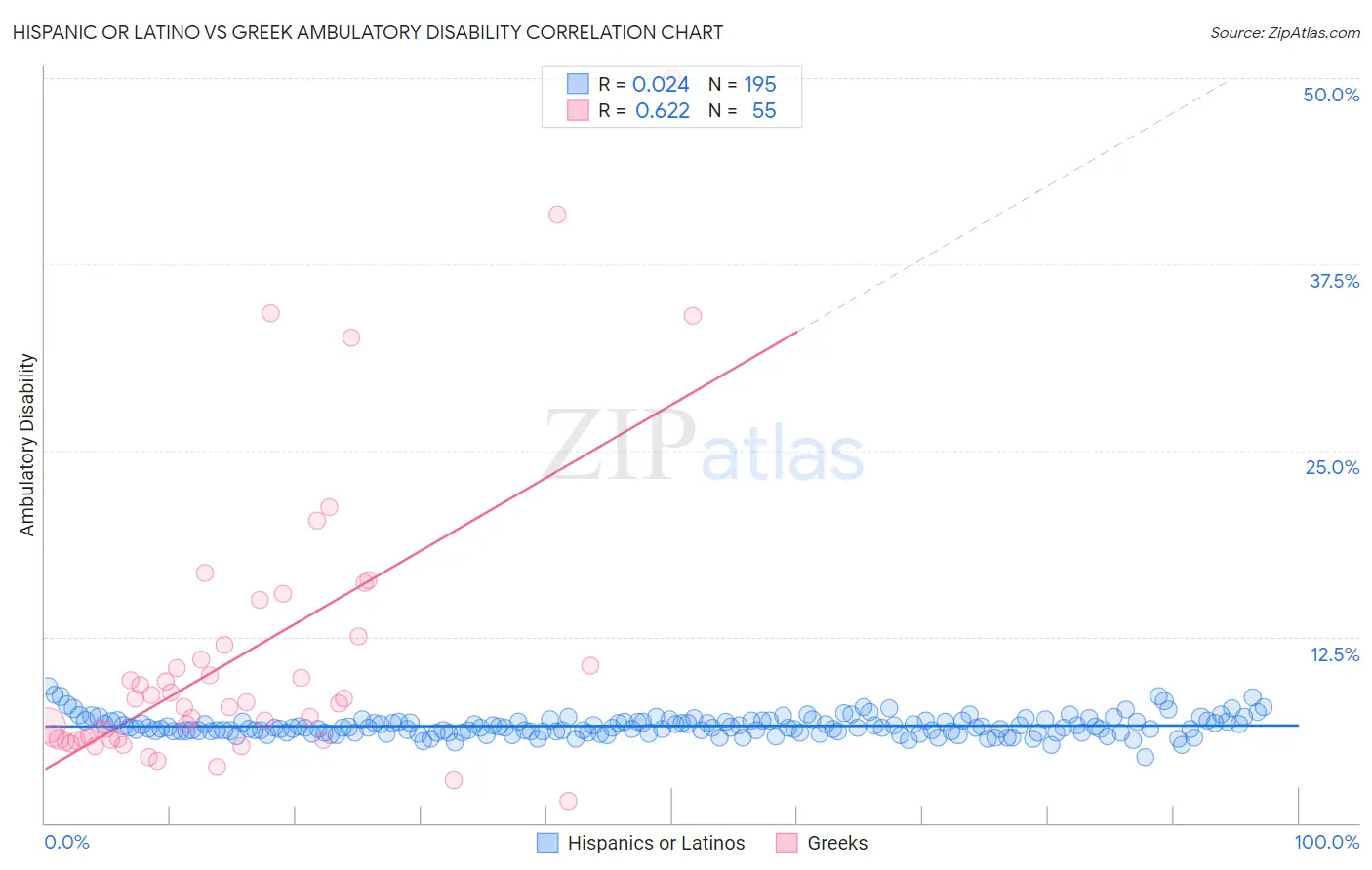Hispanic or Latino vs Greek Ambulatory Disability
COMPARE
Hispanic or Latino
Greek
Ambulatory Disability
Ambulatory Disability Comparison
Hispanics or Latinos
Greeks
6.4%
AMBULATORY DISABILITY
2.2/ 100
METRIC RATING
235th/ 347
METRIC RANK
6.0%
AMBULATORY DISABILITY
79.6/ 100
METRIC RATING
151st/ 347
METRIC RANK
Hispanic or Latino vs Greek Ambulatory Disability Correlation Chart
The statistical analysis conducted on geographies consisting of 572,469,194 people shows no correlation between the proportion of Hispanics or Latinos and percentage of population with ambulatory disability in the United States with a correlation coefficient (R) of 0.024 and weighted average of 6.4%. Similarly, the statistical analysis conducted on geographies consisting of 482,531,888 people shows a significant positive correlation between the proportion of Greeks and percentage of population with ambulatory disability in the United States with a correlation coefficient (R) of 0.622 and weighted average of 6.0%, a difference of 7.0%.

Ambulatory Disability Correlation Summary
| Measurement | Hispanic or Latino | Greek |
| Minimum | 4.4% | 1.5% |
| Maximum | 9.2% | 50.0% |
| Range | 4.8% | 48.5% |
| Mean | 6.5% | 11.2% |
| Median | 6.4% | 8.0% |
| Interquartile 25% (IQ1) | 6.1% | 5.6% |
| Interquartile 75% (IQ3) | 6.8% | 11.9% |
| Interquartile Range (IQR) | 0.75% | 6.3% |
| Standard Deviation (Sample) | 0.65% | 9.8% |
| Standard Deviation (Population) | 0.65% | 9.7% |
Similar Demographics by Ambulatory Disability
Demographics Similar to Hispanics or Latinos by Ambulatory Disability
In terms of ambulatory disability, the demographic groups most similar to Hispanics or Latinos are Immigrants from Liberia (6.4%, a difference of 0.030%), Subsaharan African (6.4%, a difference of 0.060%), Assyrian/Chaldean/Syriac (6.4%, a difference of 0.12%), Dutch (6.4%, a difference of 0.15%), and Immigrants from Germany (6.4%, a difference of 0.24%).
| Demographics | Rating | Rank | Ambulatory Disability |
| Portuguese | 4.0 /100 | #228 | Tragic 6.4% |
| Czechoslovakians | 3.8 /100 | #229 | Tragic 6.4% |
| Mexicans | 3.5 /100 | #230 | Tragic 6.4% |
| Panamanians | 3.1 /100 | #231 | Tragic 6.4% |
| Assyrians/Chaldeans/Syriacs | 2.4 /100 | #232 | Tragic 6.4% |
| Sub-Saharan Africans | 2.3 /100 | #233 | Tragic 6.4% |
| Immigrants | Liberia | 2.3 /100 | #234 | Tragic 6.4% |
| Hispanics or Latinos | 2.2 /100 | #235 | Tragic 6.4% |
| Dutch | 2.0 /100 | #236 | Tragic 6.4% |
| Immigrants | Germany | 1.8 /100 | #237 | Tragic 6.4% |
| Haitians | 1.8 /100 | #238 | Tragic 6.4% |
| Senegalese | 1.7 /100 | #239 | Tragic 6.4% |
| Immigrants | Senegal | 1.7 /100 | #240 | Tragic 6.4% |
| Immigrants | Haiti | 1.6 /100 | #241 | Tragic 6.5% |
| Spaniards | 1.6 /100 | #242 | Tragic 6.5% |
Demographics Similar to Greeks by Ambulatory Disability
In terms of ambulatory disability, the demographic groups most similar to Greeks are Immigrants from Austria (6.0%, a difference of 0.070%), Maltese (6.0%, a difference of 0.18%), Lithuanian (6.0%, a difference of 0.20%), Immigrants from Eastern Europe (6.0%, a difference of 0.21%), and Immigrants from Moldova (6.0%, a difference of 0.25%).
| Demographics | Rating | Rank | Ambulatory Disability |
| Macedonians | 82.8 /100 | #144 | Excellent 6.0% |
| Pakistanis | 82.5 /100 | #145 | Excellent 6.0% |
| Immigrants | Greece | 82.5 /100 | #146 | Excellent 6.0% |
| Immigrants | Moldova | 82.4 /100 | #147 | Excellent 6.0% |
| Immigrants | Eastern Europe | 82.0 /100 | #148 | Excellent 6.0% |
| Lithuanians | 81.9 /100 | #149 | Excellent 6.0% |
| Maltese | 81.6 /100 | #150 | Excellent 6.0% |
| Greeks | 79.6 /100 | #151 | Good 6.0% |
| Immigrants | Austria | 78.8 /100 | #152 | Good 6.0% |
| Syrians | 75.5 /100 | #153 | Good 6.0% |
| Immigrants | Croatia | 75.1 /100 | #154 | Good 6.0% |
| Immigrants | Scotland | 72.1 /100 | #155 | Good 6.0% |
| Northern Europeans | 71.8 /100 | #156 | Good 6.0% |
| Ghanaians | 71.3 /100 | #157 | Good 6.0% |
| Immigrants | Fiji | 71.2 /100 | #158 | Good 6.0% |